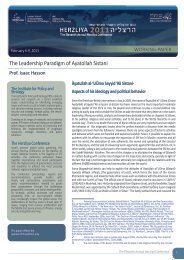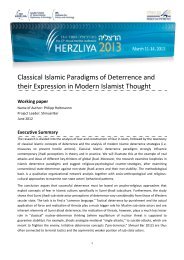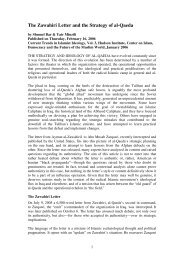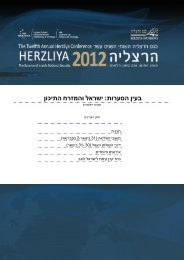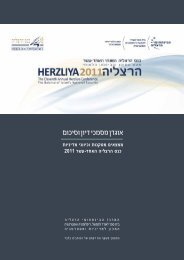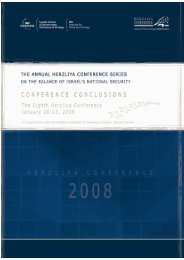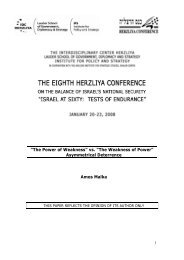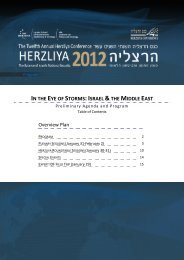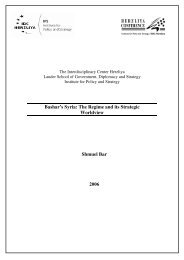Iran: Cultural Values, Self images and Negotiation Behavior
Iran: Cultural Values, Self images and Negotiation Behavior
Iran: Cultural Values, Self images and Negotiation Behavior
Create successful ePaper yourself
Turn your PDF publications into a flip-book with our unique Google optimized e-Paper software.
<strong>Self</strong>-Images <strong>and</strong> StereotypesNational <strong>Self</strong>-ImageThe prevalent <strong>Iran</strong>ian self-image is a contradictory mixture of positive <strong>and</strong>negative motifs <strong>and</strong> a constant tension between Persian <strong>and</strong> Islamic identities. On oneh<strong>and</strong>, it reflects pride of belonging to an ancient noble <strong>and</strong> imperial nation whichcontrolled most of the Middle East <strong>and</strong> which gave the world artistic, scientific, <strong>and</strong>architectural treasures centuries before Islam came on the scene, maintained itsnational language <strong>and</strong> culture after the Islamic conquest, <strong>and</strong> even succeeded in“cultural colonization” of the new empire in the realms of arts, sciences, economy,<strong>and</strong> language. 8 For <strong>Iran</strong>ians, all that was great in what is commonly referred to asIslamic or Arab culture was actually Persian. This self-image even holds certain racialovertones: it links <strong>Iran</strong> to a primordial Aryan (read noble) world of settled civilization,far superior to the "primitive" nomadic Arabian culture. It is well expressed in thecontinued use of classic Persian names with pre-Islamic <strong>and</strong> even pagan symbolism. 9Another expression is the indefatigable quest for original Persian words to replace theArabized Persian that took root in the Persian language generations ago. 10 <strong>Iran</strong>iansensitivity to national identity is evident as well in interactions with Westerners:<strong>Iran</strong>ians bristle at references to Western technological or cultural superiority (i.e., theWest being the cradle of world culture, democracy, science, etc.) or to any debt thatthe <strong>Iran</strong>ians hold towards the West.On the other h<strong>and</strong>, the same <strong>Iran</strong>ian self-image also embodies the Shiite Islamicnarrative, characterized by a strong sense of inferiority regarding power, self-<strong>images</strong>of being oppressed, conquered, <strong>and</strong> humiliated by outside forces, <strong>and</strong> identificationwith the downtrodden <strong>and</strong> with self-sacrifice. This facet of the <strong>Iran</strong>ian self-image isepitomized by identification with the Imam Ali, who was usurped as Caliph, <strong>and</strong> hissons, Hussein <strong>and</strong> Hassan, who were tricked, defeated, <strong>and</strong> killed by the treacherous<strong>and</strong> usurping Umayyad Caliph Yazid. 11<strong>Iran</strong>ian cultural studies place much emphasis on the traditional <strong>Iran</strong>ian <strong>and</strong> Shiitedifferentiation between the purity of the baten (internal) <strong>and</strong> the corruption of thezaher (external). The former is the seat of humility, compassion, generosity, <strong>and</strong> trustin God. The latter is both the source of suspicion, cynicism, pessimism, <strong>and</strong> defeatism– all of which are indicative of a lack of trust in God – <strong>and</strong> of negative or materialisticpersonal traits which are frequently attributed to Persian culture, such as shrewdness,opportunism, hypocrisy, sycophancy, <strong>and</strong> insincerity. Ideally, one should combat thelatter traits as they appear both in the outside world <strong>and</strong> in one's self, <strong>and</strong> be a person8 This is also the judgment of many great Western scholars. See D.G. Hogarth, A History of Arabia(Oxford, 1922): “Never, has captor more swiftly <strong>and</strong> subtly been captured by his captive than Arabiaby Persia.” See also Philip K. Hitti, History of the Arabs (London: Macmillan St. Martin’s Press, 1970)308: “The esthetic temperament of [<strong>Iran</strong>’s] population was a sorely needed element in the cultural lifeof the Semitic Arabs”; Carl Brockelmann, History of the Islamic Peoples (New York: CapricornBooks, 1960) 163–166.9 Such as Hormoz, a contraction of Ahura Mazda; Jamshid, after the great King Houshang; Leila, frommythology; or Ardeshir <strong>and</strong> M<strong>and</strong>ana from ancient Persian history.10 See William Forbis, Fall of the Peacock Throne (New York: Harper & Row).11 Yazid is still an epitaph in Persian for an evil-minded person.5



